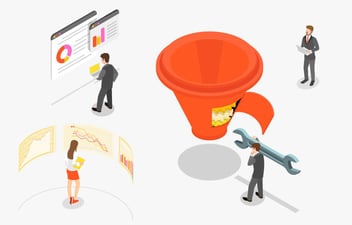An in-depth customer profile can make the difference between effective, strategic marketing, and going in blind.
But it’s what you do with the information you already have that really matters.
In this blog post, we’ll help you leverage this powerful marketing tool more meaningfully.
Here’s what we’ll cover:
- What to do with your customer profile research
- Pros and cons of customer profiles
- What to extract from your template
- 5 steps to bring your customer profile examples to life
What To Do With Your Customer Profile Research
Every great Inbound Marketing strategy starts with an exploration into the different types of ideal customers.
From their interests and hobbies - through to their pain points and daily challenges - you’ve compiled potentially reams of information about your customers and created nifty persona’s.
But how will you translate this into something helpful?
Making a list of actionable next steps after the research stage paves the way for myriad benefits, allowing you to:
- Gauge penetration rates and analyse market potential
- More readily highlight value propositions by understanding customer needs
- Reach a specific audience more effectively, and with more tailored offers
- Keep data at the heart of future marketing efforts, improving their efficacy
Before we share the 5 practical steps you can use to shape your customer profile example into tangible touchpoints, let’s take a quick look at what you stand to gain (or lose) from taking your research one step further.
Advantages and Disadvantages of Customer Profile Examples
Compiling your research has likely been time-consuming, and committing more time to it might need some convincing.
We strongly believe that actionable next steps are the defining factor between good and great Inbound Marketing campaigns.
A well-executed and developed customer profile undoubtedly has more advantages than disadvantages. Explore the benefits of expanding your customer profile below:
Advantages of Customer Profile Examples
-
- Sales and marketing teams can align their understanding of key messages, and ensure they’re plugging any potential gaps.
- Conversations can focus on the actual needs of the customer rather than the opinions of the team or any passing trends.
- The data you’ve gathered lends extra credibility to your assumptions of the customer. By factoring in how their current circumstances affect their inclination to choose you as their solution will help you sell with the right angle, every time.
- You’ll have a far clearer understanding of how to empathise with and provide support for your customer groups. The modern buyer rarely chooses the best solution or price, but rather, the best brand and business.
- It becomes easier to identify new trends and gain a competitive advantage; if, for example, the same challenges keep arising across multiple customer profiles, you’re able to quickly identify a market gap and proposition yourself as the solution, more obviously.
- Can be updated and refined over time as more information is gathered. The profile rarely becomes outdated, and can even help you anticipate future challenges.
- Creating a customer profile example helps align team thinking to a more solutions-focused outcome. When teams understand how to sell better, they will.
Disadvantages of Customer Profile Examples
-
- The outcomes may not always align with your expectations. A customer profile is fictitious after all, and even the most well-researched and informed persona can be misaligned with reality.
- Human resources must be allocated to updating the persona. This is not a task that can be completed in one day, or even by one person. The most successful customer profiles are the ones that have multiple opinions, inputs, ideas and backgrounds.
What to Extract From Your Customer Profile Template
As you can see, accurate and considered customer profiles are powerful marketing tools. But how do you make sure your B2B customer profile works as hard as it possibly can?
The B2B Ideal Customer Profile
An ideal customer profile will help you to identify the most reliable traits of the target audience and will be refined over time as your understanding of their needs, challenges, traits and restrictions develop.
By asking yourself 5 pertinent questions, you can ensure that your customer profile is robust enough to make a tangible difference in your Inbound Marketing strategy. Our blog post on customer profile best practices will help you to squeeze even more value from this activity.
Without further ado, the moment you’ve been waiting for.
5 Steps to Bring your Customer Profile Details to Life
As HubSpot Platinum Solutions Partners, we’ve helped many businesses bring their customer profile into play within their Inbound Strategy. Over this time, we’ve narrowed down the 5 aspects that will help you breathe life into your data, and evolve your customer profile template into a marketing strategy that delivers.
It’s really simple: Who. What. Where. When. How.
1. WHO is Your Customer?
It’s easier to recall your various target audiences if you make them unique.
Make each profile distinct and identifiable by giving the customer a real name: something like “Financial Director Freddie” is catchy and helps you recall that audience easily.
The more detail the better: try to paint a realistic picture of this person.
-
- Who are they at work?
-
- Title, role, designation, direct reports.
- Consider if they are decision-makers or decision-influencers to shape the angle you approach them with.
-
- Who are they at work?
-
- Who are they at home?
-
-
-
- Demographics, locations, commutes, family, responsibilities.
- If the majority of your target audience is centred around a specific area, are you optimising your website to promote Local SEO - and showing up where they are? You could go as far as adding in some colloquialisms to your content to build a deeper brand affinity.
-
- Who are they already spending their money with?
-
- Identify their favourite brands and their spending habits.
- Income brackets can help you identify the brands your customer prefers, giving you a deeper understanding of the factors that make them loyal. Higher-income bracket audiences may not find an appeal in a low-cost or budget-friendly option if they choose high-end retailers regularly, while those in the same bracket may indeed find that appealing if they regularly choose brands known for savings and cost-cutting.
-
-
-
- Who are they as a person?
-
-
- What are their traits? Jovial, serious, blunt, talkative, introverted?
- Slightly more tricky, but lends an incredible advantage to how you can speak to the audience in a way they appreciate. This helps align marketing, sales, and after-sales on a personal level that reflects your dedication to - almost literally - speaking their language.
-
2. WHAT Do They Need, and WHAT Can You Offer?
In this section, think about your key message to this customer. Write a couple of sentences that highlight what services or products you can offer that will solve their specific problems.
-
- What challenges do they face?
-
-
-
- If you can solve a problem that frees up their time, or makes them look good in their role - you’ve found the golden nugget. Find out what frustrates them most often, and highlight how you can solve that specific problem - no matter how big or small.
- If you can solve a problem that frees up their time, or makes them look good in their role - you’ve found the golden nugget. Find out what frustrates them most often, and highlight how you can solve that specific problem - no matter how big or small.
-
-
-
- What are their concerns?
-
-
-
- Perhaps they’re unsure if it’s worth their while to sign up for your product or service, or maybe they’ve had terrible experiences with a former service provider. Identify their concerns openly, and provide the assurance and support they need to overcome them.
- Perhaps they’re unsure if it’s worth their while to sign up for your product or service, or maybe they’ve had terrible experiences with a former service provider. Identify their concerns openly, and provide the assurance and support they need to overcome them.
-
-
-
- What have they already tried - and why didn’t it work?
-
-
- You could have the best marketing collateral and sales pitches, but if the prospect has already tried something similar - they likely won’t give you the time of day to pitch your offer. Lead with finding out if they’ve tried anything similar before, and why they gave it up. That way, you can ensure you’re highlighting what makes you different, and the added value you can offer.
- You could have the best marketing collateral and sales pitches, but if the prospect has already tried something similar - they likely won’t give you the time of day to pitch your offer. Lead with finding out if they’ve tried anything similar before, and why they gave it up. That way, you can ensure you’re highlighting what makes you different, and the added value you can offer.
-
3. WHERE Can You Reach Them?
Thinking about where your customer spends time online and in-person helps you to shape your promotion and outreach strategy by ensuring they actually see the content.
-
- Where do they spend time online?
- Blogs, magazines, websites, forums, specific social media channels? Are you publishing content there? If you’re not promoting your brand and content where your prospects actively spend time online, you’re narrowing down your chances of discoverability significantly.
- Blogs, magazines, websites, forums, specific social media channels? Are you publishing content there? If you’re not promoting your brand and content where your prospects actively spend time online, you’re narrowing down your chances of discoverability significantly.
- Where do they NOT spend time?
- This is just as useful as identifying their “watering holes” in the point above. If your customer actively avoids Facebook, why would you spend time (or money) promoting your content there?
- This is just as useful as identifying their “watering holes” in the point above. If your customer actively avoids Facebook, why would you spend time (or money) promoting your content there?
- Where are they spending their time in person?
- If your ideal customer spends a lot of time at hotels attending meetings and conferences, are you showing up there?
- This also tells you a great deal about the customer personally. If they spend a lot of time camping or in nature, that shows you they value tranquillity. If they prefer gyms, marathons and an active lifestyle - they’re likely energetic go-getters. Use this to inform your key messaging and how you can provide them with more of what they love.
- Where do they spend time online?
4. WHEN Are They Online?
Further understanding browsing habits lets you better optimise your promotion and outreach, maximising value and saving budget.
-
- Are they early birds or night owls?
-
-
-
- You can schedule your posts to be published at the time your audience is most likely to be active. If they’re known for late-night research, there’s no reason to schedule your content to be promoted at 6 am. Timing really is everything!
- You can schedule your posts to be published at the time your audience is most likely to be active. If they’re known for late-night research, there’s no reason to schedule your content to be promoted at 6 am. Timing really is everything!
-
-
-
- Do they work weekdays or weekends? Or both?
-
-
-
- They might face very different challenges on weekdays compared to weekends.
- Additionally, if you’re showing up with relevant content that speaks to them on their Saturday behind the desk, you’ve got a competitive advantage. While other companies shutter their activity at 6 pm on Fridays, you can schedule posts to engage with weekend workers and open the doors of opportunity in ways you’d never imagined.
-
-
-
- Will they check emails or browse the web at home?
-
-
-
- Or are they strict with their work-life balance?
- This can help you plan out and schedule your marketing automations and drip sequences in a way that factors in their habits and their environments at the time of sending.
-
-
-
- Are there special days or events you can use to leverage a key message?
-
-
-
- And inversely, which to avoid.
- Be sensitive to which events and holidays your target audience is associated with. Use this to emulate enthusiasm for events they enjoy and to earmark significant days.
- For example; a recruitment firm may want to push promotions in January when many people are looking for new jobs, rather than December when many people will be hopeful of a year-end bonus.
-
-
Again: the more precise your information, the more accurate and valuable customer profiles will be, and the stronger your message will come across.
5. HOW Will You Target Them?
Combining the above into an effective strategy involves asking questions about how you will deliver your key message.
-
- How can you deliver your message most effectively?
-
-
-
- Which formats will best deliver your message?
- Image, video, infographics, polls, emails, blog content and webinars are just a few examples. Take a look at the type of content your audience consumes most frequently - at work and in their own time. Make sure you’re formatting yours to match their expectations.
-
-
-
- How will you motivate them to engage with you?
-
-
-
- Will your customers engage with the planned medium, or have they seen it all before?
- This can help shape your calls to action, key messaging, word count, motivation, offers - you name it. Look at the content they’ve engaged with before, and find a common denominator to replicate.
-
-
-
- How will you ensure you’re actually reaching them?
-
-
-
- Consider less obvious obstacles.
- If your audience is tech-savvy and known for their dislike of paid advertising, they’ll likely have ad blockers installed. This can inform your decision to focus more on organic or user-generated content, instead of wasting time and money on paid adverts that will essentially never reach them.
-
-
There you have it: who, what, where, when and how - explained. These are just the tip of the iceberg. We have loads of innovative ways to ensure you’re delivering the right message to every prospect, every time.
Why Digital Media Stream’s Customer Profile Services Are The Best Way To Support Your Growth
Our service offering covers every step of your customer journey: the who, what, where, when and how. Now you just need us to fill the why; so, why us?
We are HubSpot Platinum Solutions Partners, trained and trusted by HubSpot. We offer over a decade of digital expertise, and our supporting digital services ensure we bring your Inbound Marketing to life.
Our team has the technical, creative and practical skills needed to find the diamonds in the rough; well shape and execute an Inbound Marketing strategy that has a real impact on your bottom line.
To learn more, book in a call with our inbound marketing experts.




